-
PDF
- Split View
-
Views
-
Cite
Cite
Stuart J. Head, Neil J. Howell, Ruben L.J. Osnabrugge, Ben Bridgewater, Bruce E. Keogh, Robin Kinsman, Peter Walton, Jan F. Gummert, Domenico Pagano, A. Pieter Kappetein, The European Association for Cardio-Thoracic Surgery (EACTS) database: an introduction, European Journal of Cardio-Thoracic Surgery, Volume 44, Issue 3, September 2013, Pages e175–e180, https://doi.org/10.1093/ejcts/ezt303
Close - Share Icon Share
Abstract
Continuous monitoring of surgical outcomes through benchmarking and the identification of best practices has become increasingly important. A structured approach to data collection, coupled with validation, analysis and reporting, is a powerful tool in these endeavours. However, inconsistencies in standards and practices have made comparisons within and between European countries cumbersome. The European Association for Cardio-Thoracic Surgery (EACTS) has established a large international database with the goals of (i) working with other organizations towards universal data collection and creating a European-wide repository of information on the practice of cardio-thoracic surgery, and (ii) disseminating that information in scientific, peer-reviewed articles. We report on the process of data collection, as well as on an overview of the data in the database.
The EACTS Database Committee met for the first time in Monaco, September 2002, to establish the ground rules for the process of setting up the database. Subsequently, data have been collected and merged by Dendrite Clinical Systems Ltd.
As of December 2008, the database included 1 074 168 patient records from 366 hospitals located in 29 countries. The latest submission from the years 2006–08 included 404 721 records. The largest contributors were the UK (32.0%), Germany (20.9%) and Belgium (7.3%). Isolated coronary bypass surgery was the most frequently performed operation; the proportion of surgical workload that comprised isolated coronary artery bypass grafting varied from country to country: 30% in Spain and almost 70% in Denmark. Isolated valve procedures constituted 12% of all procedures in Norway and 32% in Spain. Baseline demographics showed an increase in the mean age and the percentage of patients that were female over time. Remarkably, the mortality rates for all procedures declined over the period analysed, to 2.2% (95% confidence interval [CI] 2.2–2.3%) for isolated coronary bypass, 3.4% (95% CI 3.3–3.5%) for isolated valve and 6.2% (95% CI 6.0–6.5%) for bypass + valve procedures.
The EACTS database has proven to be an important step forward in providing opportunities for monitoring cardiac surgical care across Europe. As the database continues to expand, it will facilitate research projects, establish benchmarking standards and identify potential areas for quality improvements.
INTRODUCTION
Adult cardiac surgery is performed extensively throughout Europe. Isolated coronary artery bypass grafting (CABG) and isolated valve surgery are the most commonly performed cardiac operations. Data from the Organization for Economic Co-operation and Development (OECD) showed that the average rate of CABG procedures in western countries is 62 per 1000 inhabitants, but ranges between 29 in Spain and 135 in Belgium [1].
Continuous monitoring of surgical procedures has become increasingly important to (i) report the safety and efficacy of procedures, (ii) assess the appropriateness of usage [2], (iii) benchmark outcomes, (iv) evaluate trends in the community, (v) appraise governmental interventions and (vi) estimate healthcare expenditure. The best way to achieve these goals is to encourage states/countries to join forces in establishing a large database. In the USA, the Society of Thoracic Surgeons (STS) initiated the STS National Adult Cardiac Surgery Database, which started collecting patient-level records in the 1980s [3]. From this continuously growing dataset, the STS has provided an enormous body of evidence in the field of cardiac surgery, ranging from position papers [4] to guidelines [5], and from regional studies [6] to large comparative effectiveness analyses [7].
In Europe, a number of countries have also instituted national registries. However, comparisons between European countries are cumbersome because of differences in practice, definitions and methods used for the acquisition of data. A systematic international collaboration would provide consistency and allow ‘fair’ comparisons. The European Association for Cardio-Thoracic Surgery (EACTS) has succeeded in establishing such a network, with the goals of (i) working with other organizations towards comprehensive data collection to create a European-wide repository of information on the practice of adult cardiac surgery, and (ii) disseminating that information in such a way that it is easily accessible and understandable to the surgical community, patients and the general public [8–11]. This will provide invaluable assistance to surgical teams when they are in negotiation with healthcare providers, enabling them to acquire the appropriate resources for their patients and allowing them to develop and hone surgical practice so as to ensure the continued improvement in outcomes for patients.
Although the EACTS database has been ongoing since 2003 [8], it has not yet been used as a source for scientific studies. In the near future, EACTS will endeavour to produce several papers. As a first step, we report on the process of data collection, as well as on an overview of the data in the database.
METHODS
Data collection
The EACTS Database Committee met for the first time in Monaco, September 2002, to establish the ground rules for the process of setting up the database:
EACTS would use the American STS dataset with several adaptations to suit European demographics and to collect the variables included in the EuroSCORE models.
Data import would be primarily organized through national registries, so i) the data would already have been cleaned and processed, ii) it would ensure ownership of data by the national registries and iii) it would be less time consuming and simpler for the EACTS team. One downside of this approach, however, could be that some countries might have a more advanced national registry than others, and some of the more established National Datasets, while comprehensive, might be significantly divergent from the requested dataset. For countries with no over-arching National Database Program, contributions would be accepted from individual hospitals.
Dendrite Clinical Systems Ltd. (Oxfordshire, UK) would host the database and take care of data management and analysis.
A first report of the EACTS dataset would be presented in 2003 and repeated thereafter.
The Database Committee, with oversight from the EACTS council, was installed to manage the database. After the meeting, the chairman of the committee sent an invitation to the chairmen of 23 national registries to ask them to participate. Invitation letters are still sent out every year to encourage past contributors to send their most recent data and to persuade more hospitals and countries to begin contributing.
Individual, anonymized patient-level data provide the core of the database; submissions of aggregated data analyses were not appropriate for this project. Source files needed to be submitted as Microsoft Access™, Microsoft Excel™ or Tab-delimited text files, to allow some preimport file manipulation and validation so as to ensure uniformity between datasets before merging. To avoid miscategorization of variables, a full data dictionary was required, particularly where abbreviations or encoding systems had been used. For datasets in languages other than English, a full translation was also required.
Various logic checks and validation processes were applied by the Dendrite team to ensure that major problems with data or issues with formatting were identified. In some cases, extensive dialogue was required between Dendrite and the contributors to investigate potential problems and take the appropriate remedial action so that data could then be resubmitted in the correct format [11].
Definitions
The EACTS database includes two outcome measures: postoperative length of stay (LOS) and all-cause mortality. Postoperative LOS was defined as the number of days between the procedure and discharge. Due to different opinions with regard to the time interval of procedural mortality, mortality was more difficult to define. Variation in using the definitions (e.g. in-hospital, 30-day, 60-day and 90-day) may be apparent across hospitals and national registries. Therefore, the EACTS database uses the discharge status, and mortality thus represents death within the index hospitalization.
Statistical analysis
The last data collection was performed in 2009 [11, 12]. Trends are presented as observational only, and no P-values were calculated. Postoperative LOS was presented as median with inter-quartile range (IQR).
RESULTS
Since the inception of the EACTS database, four reports based on the accumulated data have been published [8–11]. In 2003, the database included datasets from 99 hospitals located in 12 countries [8]. For the last database report in 2009 [11], data were available from 366 hospitals located in 29 countries, including non-European countries (China and Hong Kong) (Supplementary Data) [11, 12]. Figure 1 provides an overview of the accumulation of patient records in the database. Data of 1 074 618 patients were included in the database, among which were the latest submissions of 404 721 records. The largest contributions came from the UK (32.0%), Germany (20.9%) and Belgium (7.3%), together providing >60% of all records in the database (Fig. 2). Trends of data submission are depicted in Fig. 3. Completeness of submitted data is listed in Fig. 4.
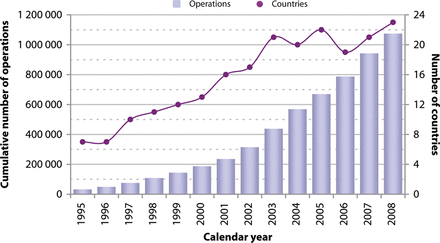
The number of contributing countries and the cumulative number of submitted patient records (n = 1 074 618).
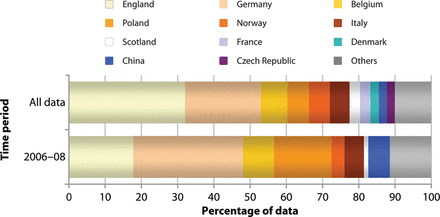
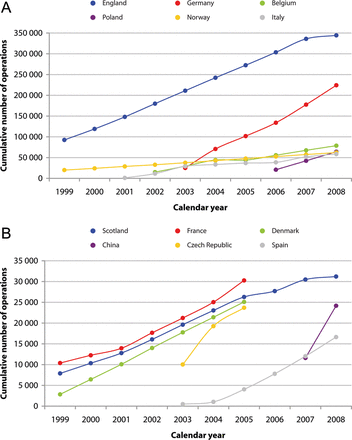
Trends in submission of patient records per contributing country. The number of submitted patient records of high-volume (A) and mid-volume (B) contributors was 832 135 and 151 055, respectively, and together accumulated to 91.5% of all patient records.
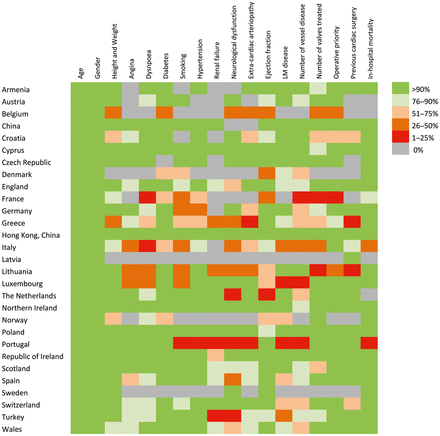
Completeness of the data from each individual country. LM: left main.
Information on the procedure performed was available for 1 057 091 patient records. Isolated CABG was the most frequently performed, ranging from approximately 30% of all cases in Spain to almost 80% in Armenia (Fig. 5). Of the medium- and high-volume contributors, the percentage of procedures that were isolated CABG varied from 50% in Belgium (n = 78 739) to 70% in Denmark (n = 25 090). The next most common procedure was isolated valve surgery. This made up only 12% of all procedures in Norway (n = 62 123) to 32% in Spain (n = 16 629).
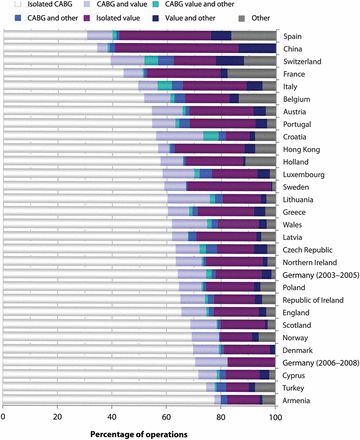
Procedures performed per contributing country. Isolated CABG was most frequently performed, but shows a large variation between countries. ‘Other’ is defined by a procedure that cannot be categorized as CABG or valve surgery, for example, major aortic surgery. CABG: coronary artery bypass grafting.
Analysis of the patient demographics demonstrated a gradual increase in both the patients' mean age (n = 1 021 991 available for analysis) and in the proportion of patients undergoing surgery who were female (n = 964 918 available for analysis; Fig. 6).
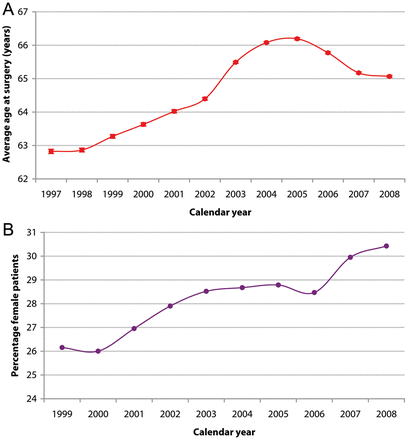
The trend of age and gender of patients included in the database. The data show an increase in the mean age (A) and the percentage of female patients (B).
Postoperative LOS was available for 348 523 cases operated on in the years 2006–08. It was not normally distributed and differed for procedure groupings (Fig. 7). Median LOS after isolated CABG was 8 (IQR = 6–11) days, after isolated valve surgery it was 9 (IQR = 7–14) days, and 10 (IQR = 7–15) days after CABG + valve procedures.
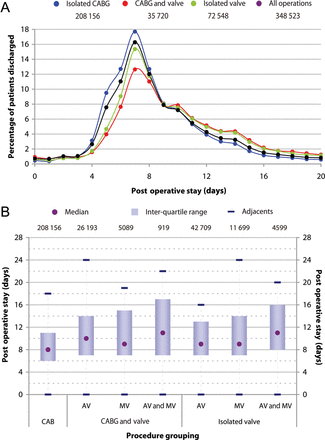
Postoperative LOS for different procedure groupings. The distribution of LOS was not normally distributed (A) and showed variability after different procedures (B). Data for this analysis were only available from the years 2006–08. AV: aortic valve; MV: mitral valve; CABG: coronary artery bypass grafting.
Mortality among patients undergoing cardiac surgery has decreased in all procedure groupings (Fig. 8). In the latest 3-year period recorded in the database (2006–08), the mortality rate of patients undergoing isolated CABG (n = 219 053) was 2.2% (95% confidence interval [CI] 2.2–2.3%), for isolated valve (n = 75 247) it was 3.4% (95% CI 3.3–3.5%) and for CABG + valve (n = 37 721) it was 6.2% (95% CI 6.0–6.5%).
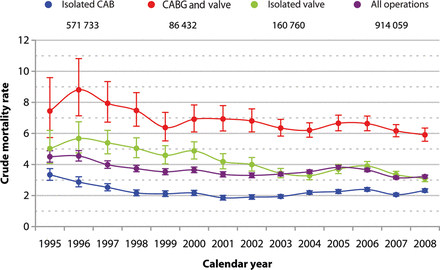
Trends in mortality for different procedure groupings. There has been a minor but definite decrease in in-hospital mortality in all procedures. Data for this analysis were missing from Netherlands (100%), Latvia (100%), Belgium (100%), Portugal (∼78%), Italy (∼65%) and France (∼20%). For all other countries, mortality data were available in >95% of cases. CABG: coronary artery bypass grafting.
DISCUSSION
The EACTS database initiative, begun in 2002, has already realized a merged database with over 1 million patient records from 366 hospitals located in 29 countries [11]. These data provide valuable insights into the current status of cardiac surgical practice across Europe and demonstrate great variability across geographic regions. The inclusion of data from so many countries allows for valuable estimates of population and outcome trends. Patients presenting for cardiac surgery seem to be coming with ever-more complex disease patterns and with elevated risk profiles (increased age and number of comorbidities), but at the same time the pan-European estimates of postoperative mortality for the major procedure categories have declined.
The number of surgical myocardial revascularizations varies widely across geographical regions in western countries [1, 13]. Some of the differences in reported procedure rates may be explained by country-to-county variations in the relative rates of percutaneous coronary intervention (PCI) and CABG used for the front-line treatment of coronary artery disease [14]. The PCI-to-CABG ratio varies significantly between countries [1] and is largest in Spain, with a ratio of 8.63:1. The data in the EACTS database from Spain show that 31% of procedures are isolated CABG [11], which is significantly less than the 65% we found in the UK where the PCI-to-CABG ratio is 2.03:1 [1].
Data from the Euro Heart survey also suggest that there might be a (non-significant) geographical difference in the decision to operate on patients with severe aortic stenosis, ranging from 57% in Eastern Europe to 73% in Western Europe [15]. In the original EuroSCORE database, the number of surgical valve procedures also varied significantly between Northern and Southern countries [16]. Our study shows large differences between individual countries with respect to the relative numbers of valve procedures performed.
Numerous studies have shown an increase in both the mean age of patients presenting for surgery [12, 17–20] and the incidence of comorbidities [17–21]. High-risk patients form an increasingly larger proportion of the cohort of patients undergoing cardiac surgery. However, mortality in these high-risk patients is poorly predicted by the EuroSCORE [22], highlighting the need for an accurate up-to-date risk prediction model for European cardiac surgical patients. The recently introduced EuroSCORE II may be an improvement [23], but some limitations have already been identified [24].
Paradoxically, the increase in the complexity of patients has coincided with reduced procedural mortality [11]. Between 1995 and 1998, the operative mortality after isolated CABG reduced almost annually and now remains approximately 2% (Fig. 8). Mortality after isolated valve operations showed a continuous decline to 3.4% in 2008. Mortality after combined CABG and valve procedures also fell, from almost 9% to approximately 6% over the period from 1996 and 2008. In the long term, monitoring of (risk-adjusted) mortality will be crucial to help identify the areas where there is a need for further procedural refinements and innovative techniques.
Limitations
The current EACTS database provides a good overview of cardiovascular surgical practice in Europe, but we have identified areas that are in need of improvement. Unfortunately, it is not appropriate to compare the mortality rates between countries, because adjustment for the types and complexity of patients and procedures cannot be performed adequately. One aim of the EACTS Database Committee is to promote the development of the registry, so that it can eventually accommodate these kinds of analyses.
The database could be enhanced by making it more comprehensive with the inclusion of data from more hospitals and more countries. There are some countries that had submitted data in the past, but unfortunately chose not to participate in the last round of data submission (Fig. 3). Other countries have never participated in this project, and it would be extremely valuable to have their data included in the database, not least for the sake of completeness. Furthermore, our regional analyses (Fig. 4) depend on the centres that submitted data. The submitted data unfortunately often did not represent the complete number of cases of a country, and it could not be determined what the percentage of submitted data was. Therefore, these regional trends should be interpreted with caution.
The percentage of missing data in the submissions from some countries is another area for potential improvement (Fig. 4) [11]. Using a web-based data submission tool with concomitant data validation checks and early recognition of errant or missing data could help to drive improvements in data quality and so increase the overall utility of the database. Complete data would provide accurate trend analysis and allow for proper risk-adjusted mortality analysis. One key requirement is that all participating centres standardize on one definition for mortality (e.g. in-hospital or 30-day mortality). Currently, the interpretation of mortality rates warrants some caution because the data are submitted on a voluntary basis without any external validation. In-hospital mortality rates may vary according to differences in discharge protocols. For example, the median postoperative LOS after isolated CABG is 5 days in the UK, and 9 days in France [11]. Data from the STS database have also found inexplicable variability in postoperative LOS that was not correlated with the patient's risk profile [25]. Other factors should be taken into consideration as well, such as the distance between the patient's home and the hospital, as in rural areas a longer postoperative hospitalization may be more appropriate, and the availability of nursing facilities, or discharging patients from tertiary hospitals to their general hospitals for final recovery.
CONCLUSION
Despite its shortcomings, the EACTS database has proven to be an important step forward in providing opportunities for monitoring cardiac surgical care across Europe. As the database continues to expand, it will facilitate research projects, establish benchmarking standards and identify potential areas for quality improvements.
PERMISSION
Figures are reprinted with approval from Dendrite Clinical Systems Ltd. and the European Association for Cardio-Thoracic Surgery [11].
SUPPLEMENTARY MATERIAL
Supplementary material is available at EJCTS online.
Conflict of interest: Peter Walton has financial interests in Dendrite Clinical Systems Ltd., a clinical software and publishing company, that handled data collection and data managing for the EACTS database, as well as undertook the analyses and published the EACTS Adult Cardiac Surgery Database reports. Peter Walton is a paid employee of Dendrite Clinical Systems Ltd.




